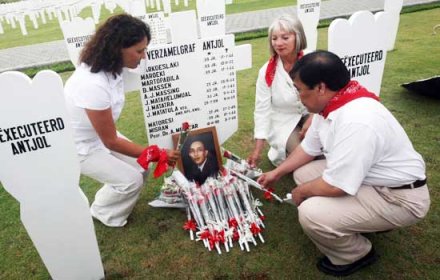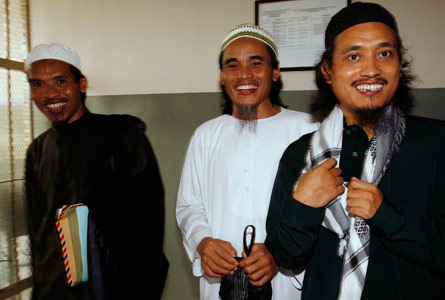On this date in 1975, the wife of East Timor’s Prime Minister was publicly executed on the docks of her conquered country’s capital.
 By the happenstances of colonial expansion, East Timor, a 15,000-square kilometer half-island in the Lesser Sundas, chanced to have the Portuguese flag planted on its soil instead of (as characterized the rest of its surrounding Indonesian archipelago) the Dutch.
By the happenstances of colonial expansion, East Timor, a 15,000-square kilometer half-island in the Lesser Sundas, chanced to have the Portuguese flag planted on its soil instead of (as characterized the rest of its surrounding Indonesian archipelago) the Dutch.
Because of this, Timor-Leste did not walk the same path trod by Indonesia: it did not share in Indonesia’s 1945 revolution breaking away from the Netherlands, nor in the 1965 coup d’etat that put the Suharto military dictatorship in charge of that country.
While these years of living dangerously played out throughout the vast island chains, and even in West Timor, little East Timor remained Portuguese property into the 1970s.
But by that time, colonialism was wearing out its welcome in that onetime maritime empire. A long-running, and ever more unpopular, war against independence fighters in Portugal’s African colonies finally helped to trigger the mother country’s 1974-75 Carnation Revolution and a new regime interested in immediate decolonization.
Abruptly — arguably, too abruptly — Portugal began divesting herself of her onetime empire’s onetime jewels, including not only East Timor but Goa on the coast of India (oops), and the African states of Guinea, Mozambique, and Angola. These would immediately become contested violently by proxies backed by the United States and the Soviet Union.
Though easily the least lucrative and strategically essential of these forsaken colonies, Timor too felt the the Cold War’s hand.
Western-allied Suharto eyed warily the Timorese left-wing insurgent movement turned political party that went so far as to declared Timorese independence in November of 1975. In response, Indonesia gathered the main opposition parties under its own umbrella and had them produce a declaration calling for — wouldn’t you know it? — unification with Indonesia.
By that time, the fall of 1975, it was becoming apparent that such a unification would soon be a fait accompli. Indonesian commandos were penetrating East Timor, even making bold enough to murder western journalists. On December 7, 1975, Indonesia invaded East Timor with the blessing of Washington, D.C.*
The ensuing 24-year occupation was a notorious bloodbath, and Indonesian troops set the standard right from day one … or, in this case, day two.
On December 8, in the now-occupied capital city of Dili, dozens of Timorese elites were marched to the quay under the frightened gaze of their countrymen and -women, and there publicly shot into the harbor. Notable among them was Isobel Lobato, the wife of Nicolau Lobato, who had been the prime minister of Timor’s brief moment of independence in 1975.
Nicolau Lobato himself did not share his wife’s fate, however. He escaped into the bush where he helped lead a remarkably persistent anti-occupation guerrilla movement until he was finally killed in a firefight in 1978. Post-independence, Dili’s Presidente Nicolau Lobato International Airport was re-named in his honor.
* President Gerald Ford and his fell henchman Henry Kissinger flew out of Jakarta hours before the invasion, arriving in Hawaii where they would demur on reporters’ inquiries as to whether they had green-lighted the unfolding incursion. Daniel Patrick Moynihan, who was at that time America’s U.N. envoy, boasted in his memoirs that “The United States wished things to turn out as they did, and worked to bring this about. The Department of State desired that the United Nations prove utterly ineffective in whatever measures it undertook. This task was given to me, and I carried it forward with no inconsiderable success.”
On this day..
- 1452: Antonio Rizzo, cannonaded - 2019
- 1718: Avram Lopukhin, Peter the Great's brother-in-law - 2018
- 1905: Mary Rogers, chloroformer - 2017
- 1915: Cordella Stevenson lynched - 2016
- 1746: Charles Radclyffe, twice Jacobite rebel - 2015
- 1934: John and Betty Stam, China missionaries - 2013
- 1922: Four anti-Treaty Irish Republicans - 2012
- Hand of Glory: 1,500 days and counting - 2011
- 2009: Yang Yanming, hedge fund manager - 2011
- 1828: Joseph Hunton, forger - 2010
- Themed Set: Reputation - 2010
- 1982: Suriname's "December murders" - 2009
- 1793: Madame du Barry, who hated to go - 2008
- 1596: Francisca Nunez de Carvajal, her children, and four other crypto-Jews of her family - 2007





 Soumokil was captured in December 1962 and imprisoned; he was executed* just a month after the Indonesian government was
Soumokil was captured in December 1962 and imprisoned; he was executed* just a month after the Indonesian government was